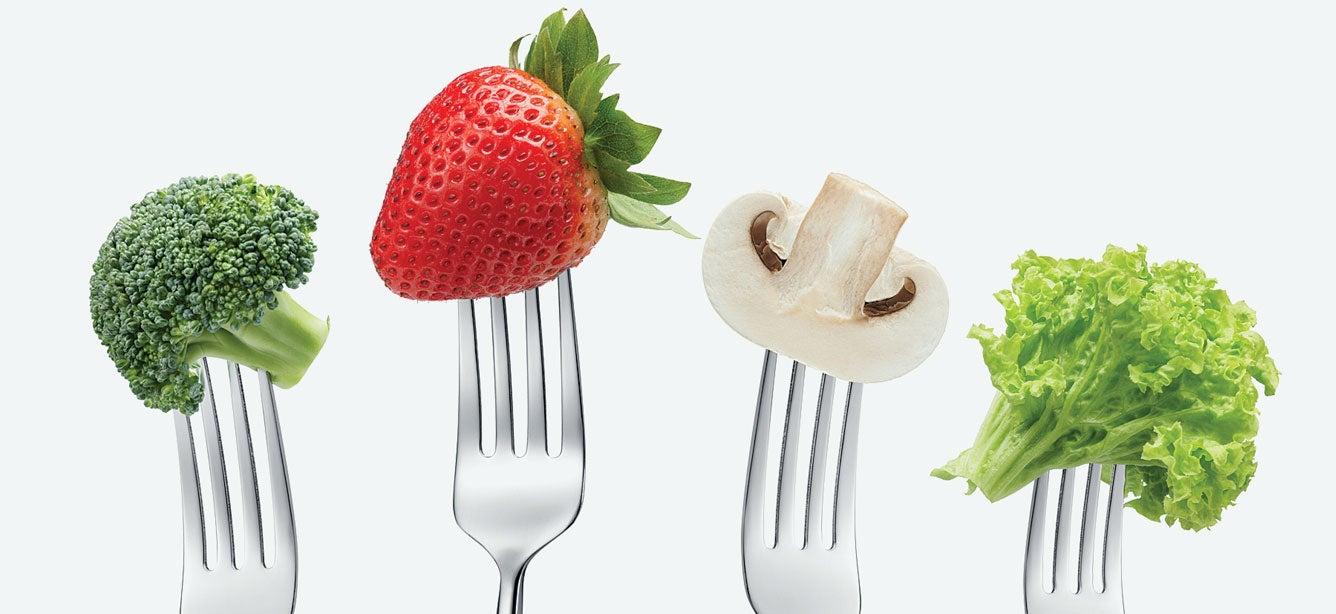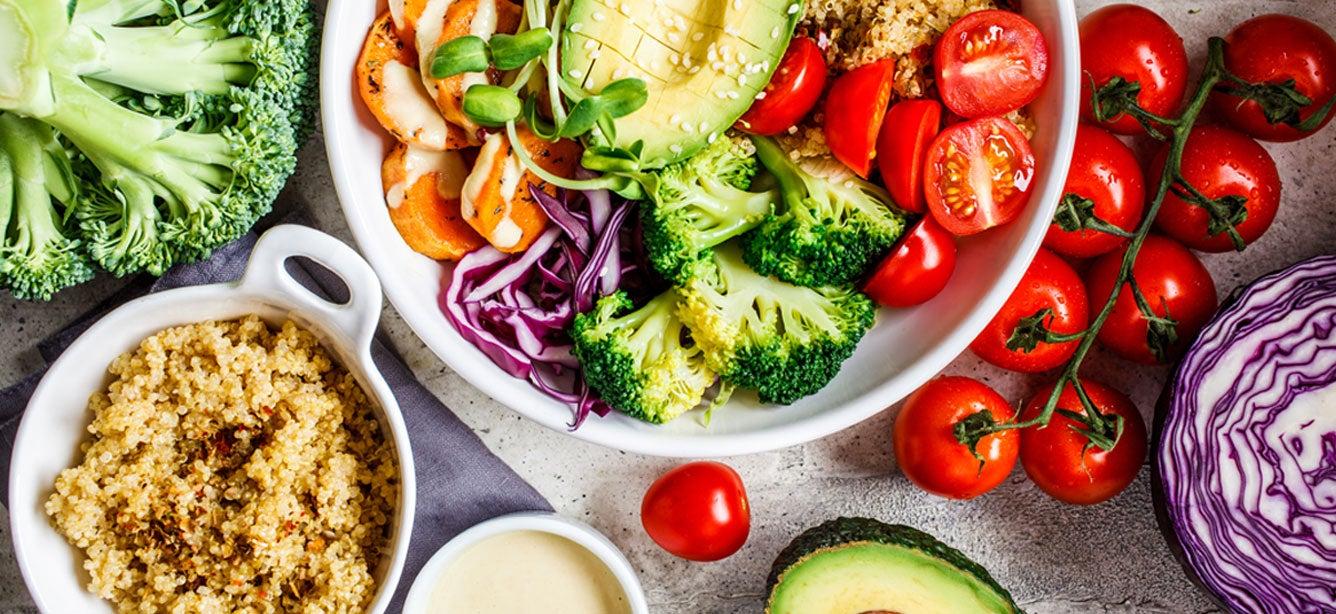
Related Topics
Following a balanced meal plan at home can help nourish your mind, body, and spirit—and keep your bank account looking healthier, too. With a little planning and a spark of inspiration, you can be on your way to enjoying delicious meals that are good for you, too.
Here are five tips to help you create meal plans filled with healthy foods that you and your family are sure to enjoy.
1. Review healthy eating guidelines
A good place to start is with your healthcare professional, who can help you set diet and nutrition goals and benchmarks. “A registered dietitian nutritionist (RDN) can work with you to create an eating plan that’s tailored to your needs,” says Gretchen Dueñas-Tanbonliong, Associate Director of Health and Wellness at NCOA and an RDN herself. "When it comes to meeting nutrition requirements, there’s no one-size-fits-all approach.”
And while there are dietary guidelines that apply for most age groups—like choosing nutrient-dense foods and limiting added sugar—there are special considerations for older adults, too:
- The U.S. Department of Agriculture (USDA)'s Dietary Guidelines for Americans, 2020-2025, recommend that older adults pay special attention to protein intake, since about half of women and a third of men age 71 and older don’t eat enough of it.1 Learn about the best protein sources for older adults.
- Older adults may need to eat more foods fortified with vitamin B12, or take a supplement, since aging can reduce absorption of this vital nutrient.
- Some older adults may face barriers to eating well, such as low appetite and difficulty chewing and swallowing. Explore common nutrition challenges of older adults and practical strategies to overcome them.
2. Gather inspiration
As you create your healthy meal plan, you may want to rekindle your culinary creativity. Search your favorite websites and cookbooks for recipes that will add variety and excitement to your menus. You’ll find recipes for every taste, cultural tradition, and cooking style.
Breakfast on your healthy meal plan could be a bowl of bran flakes cereal, topped with vitamin C-rich blueberries and low-fat milk. But it could also be eggs over kale and sweet potato grits. Or, for those days when you’re in a hurry to get to the pickleball court, overnight no-cook banana oatmeal.
3. Choose foods that do double-duty
Join the Academy of Nutrition and Dietetics in embracing food as “preventative medicine to encourage health and well-being.” Healthy eating at home should be nutritious and delicious.
Pack your meals with anti-inflammatory foods like legumes and apricots, which experts say can offer protection against type 2 diabetes, cardiovascular disease, and other conditions. Add flavonoid-rich berries to help boost memory. Fill your salad bowl with leafy greens, a nutritional powerhouse, and sprinkle them with slivered almonds, which are filled with protein and phytonutrients that support gut health.
4. Always be prepared
Don’t let a missing ingredient sabotage your healthy meal plan or trigger a dinner delivery impulse buy. A well-stocked pantry, refrigerator, and freezer can help you stay the course and keep your meals budget friendly. The American Heart Association suggests having these items on hand:
- “Dinner builder” items: canned or dried beans, such as kidney, pinto, black, butter and navy; canned or pouched tuna, salmon and chicken; spaghetti sauce
- Canned vegetables: for easy side dishes and adding to soups and sauce
- Whole grains: brown rice, oats, couscous, bulgur and quinoa; whole-grain pastas, breads and tortillas (store extra bread and tortillas in the freezer); whole-grain flour or cornmeal for baking
- Cooking oils: non-tropical vegetable oils, such as olive, canola and corn
- Nuts, seeds and nut butters: for stir-fries and garnishes (and satisfying snacks)
- Broths: fat-free, low-sodium chicken, vegetable and beef—for making soups
- Dried herbs and spices: keep a variety on hand and buy or create salt-free seasoning blends
- Proteins: Unbreaded fish fillets, skinless chicken breasts, extra-lean or lean meats; tofu
- Dairy products: low-fat and fat-free milk, yogurt and cheese
- Soft margarine: made with nonhydrogenated vegetable oil and containing no trans-fat
- Frozen vegetables and fruits: choose a wide variety (lots of colors) without salty sauces and sugary syrups
Tailor the list to meet your tastes, healthy eating guidelines, and budget. And remember, you can shop for these staples using your Supplemental Nutrition Assistance Program (SNAP) benefits. If you're wondering whether you're eligible for SNAP, visit NCOA's BenefitsCheckup.org to find out. You can also get help applying for this and other benefit programs that can help you age well.
5. Consult other healthy-eating meal plans
When you’re ready to create your own food plan, get a head start by reviewing templates from trusted sources. This can help save you time and speed you toward your goal of healthy eating at home.
The Dietary Approaches to Stop Hypertension (DASH) meal plan, developed by researchers for the National Heart, Lung, and Blood Institute (NHLBI), is flexible and heart-healthy. You can download or order a printed copy of a healthy meal plan for a week. These menus are based on 2,000 calories a day but can be tailored to other daily calorie levels and nutritional needs.
A typical DASH day may start with whole grain cereal, fruit, and fat-free yogurt. For lunch, you may choose from a range of sandwich choices, including tuna salad, barbecue beef, and chicken breast. A healthy dinner meal plan might include zucchini lasagna, or roast beef with a lightened-up version of a stuffed baked potato, with fat-free sour cream, reduced-fat cheddar cheese, and chopped scallions as toppings. Daily snacks include items like almonds, dried apricots, graham crackers, and peanut butter.
The USDA’s MyPlate offers a two-week sample healthy meal plan and a customized grocery list. The National Institute on Aging (NIA) offers meal planning tips and sample menus.
Oldways, a food and nutrition nonprofit, puts its focus on healthful diets based on diverse cuisines. You can build your own plan for healthy eating at home by choosing recipes from Mediterranean, African Heritage, Latin American, Asian Heritage, and Vegetarian & Vegan diets.
Following a balanced diet meal plan can help you reap the benefits of healthy eating and give you more time to enjoy your leisure activities.
Source
1. American Heart Association. The changing nutritional needs of older adults and how to meet them. December 18, 2024. Found on the internet at https://www.heart.org/en/news/2024/12/18/the-changing-nutritional-needs-of-older-adults-and-how-to-meet-them




